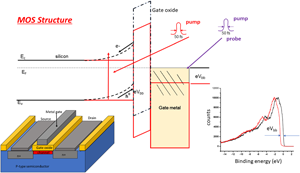Article contents
Electronic structure of technologically important interfaces and heterostructures
Published online by Cambridge University Press: 24 August 2020
Abstract

From thin film solar cells to metal–oxide–semiconductor (MOS) devices in leading edge integrated circuits, the electronic structure at and near the interfaces between component materials determines the most important fundamental operating characteristics of those devices such as turn-on voltage, power dissipation, and off-state current leakage. Fermi level location at buried interfaces, semiconductor (SC) band bending, charge transfer, oxide defects, and work functions of the constituent materials all contribute to device performance. This paper describes how these important parameters can be determined by employing femtosecond photovoltage spectroscopy, an extension of ultraviolet photoelectron spectroscopy (UPS) using ultrafast lasers. While standard UPS is fundamentally a surface-sensitive spectroscopy, pump/probe techniques add a new dimension to this venerable spectroscopy, permitting the accurate extraction of the underlying band bending in SCs. When combined with the valence band edge location of the SC and oxide, and determination of the system Fermi level, full characterization of the electronic structure of a MOS stack can be obtained providing key insights on device operating properties. This approach can be extended to study key device materials in emerging areas of artificial intelligence and quantum computing. In each case, surprising new details were uncovered that led to performance optimization of these technologically important devices.
- Type
- Prospective Articles
- Information
- Copyright
- Copyright © The Author(s), 2020, published on behalf of Materials Research Society by Cambridge University Press
References
- 1
- Cited by





